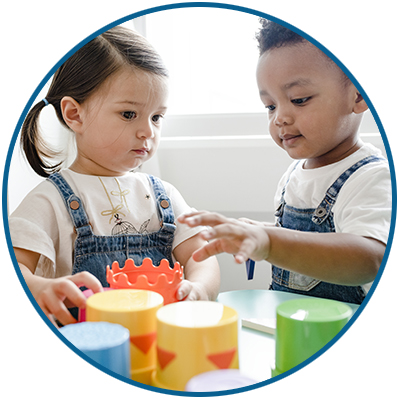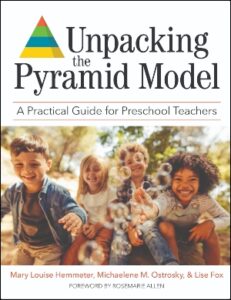Unpacking the Pyramid Model: Frequently Asked Questions

Research has consistently shown that young children who develop a solid base of social-emotional skills are more likely to achieve positive outcomes inside and outside of school. Because children are not born knowing how to manage their own emotions, empathize with others, or form and sustain healthy peer relationships, early learning environments are essential venues for social-emotional development.
The Pyramid Model for Promoting Social Emotional Competence in Infants and Young Children was created to give programs like yours an evidence-based framework for nurturing the social-emotional development of all children, with more intensive, tiered supports for children at risk for social-emotional delays and children who engage in persistent challenging behaviors.
Adapted from the new book Unpacking the Pyramid Model by Mary Louise Hemmeter, Michaelene M. Ostrosky, and Lise Fox, this brief Q&A answers a few commonly asked questions about the Pyramid Model. Read on for more information on the three tiers of Pyramid Model interventions, the important role that families play in stimulating social-emotional growth, and more.
1. Is the Pyramid Model a curriculum that I can purchase?
 The Pyramid Model is not a curriculum; rather, it is a conceptual framework of evidence-based practices for promoting young children’s social-emotional development. The Pyramid Model consists of three tiers of interventions: universal practices for all children, targeted instruction for children who are at risk of social-emotional delays, and individualized behavior supports for children with significant social skill deficits or persistent challenging behavior.
The Pyramid Model is not a curriculum; rather, it is a conceptual framework of evidence-based practices for promoting young children’s social-emotional development. The Pyramid Model consists of three tiers of interventions: universal practices for all children, targeted instruction for children who are at risk of social-emotional delays, and individualized behavior supports for children with significant social skill deficits or persistent challenging behavior.
2. My program requires that we use a particular social-emotional curriculum. Can I also use the Pyramid Model in conjunction with that curriculum?
The Pyramid Model is not intended to replace an existing curriculum. It’s quite likely that the social-emotional curriculum your program currently uses is consistent with the Pyramid Model, which provides a framework within which teachers can successfully implement a curriculum. Many teachers use a curriculum to structure their social-emotional lessons along with the Pyramid Model, which provides guidance about how to create a social context in which to implement social-emotional teaching practices.
3. My school is implementing a Multi-Tiered System of Support (MTSS). Can I still implement Pyramid Model practices?
Yes. An MTSS is a data-based framework that helps ensure positive academic, behavioral, and social-emotional outcomes for all students, by matching their individual needs with appropriate resources and interventions. Many programs have successfully implemented, scaled up, and sustained the implementation of the Pyramid Model as an MTSS for promoting young children’s social-emotional competence and addressing challenging behavior.
Want to learn more about Multi-Tiered Systems of Support? Check out Multi-Tiered Systems of Support for Young Children: Driving Change in Early Education.
4. My school is implementing Positive Behavior Interventions and Support (PBIS). How does the Pyramid Model work with PBIS?
Upcoming and recorded webinars from Unpacking the Pyramid Model chapter authors.
The Pyramid Model is a PBIS framework that early educators can use to promote children’s social-emotional development and prevent and address challenging behavior. Many schools that adopt PBIS use the Pyramid Model to guide the implementation of practices in early childhood classrooms. (PBIS.org includes information about the use of the Pyramid Model in the implementation of PBIS.) As a PBIS framework, the Pyramid Model is designed to improve social competence and academic outcomes, but it uses data-driven tools and evidence-based practices that are developmentally appropriate for preschool children.
5. Is there a child assessment component to the Pyramid Model?
The Pyramid Model has no specific child assessment associated with the framework. In recent years, there has been a growing emphasis on the mental health and the social, behavioral, and developmental needs of very young children. In response, state administrators and local providers of infant and preschool programs have worked to strengthen their screening and assessment of children’s social-emotional development.
6. Can I use the Pyramid Model with children who have special needs?
Yes. When the Pyramid Model was developed, it was designed to include practices that promote the social-emotional competence of all children, including children with or at risk for developmental disabilities. Research on the implementation of the Pyramid Model has been conducted in inclusive classrooms and in classrooms that serve children with special needs, and results indicate teacher-reported growth in social skills and a reduction of challenging behavior.
7. Can the Pyramid Model help to reduce challenging behaviors in the classroom?
 Yes! We have found that implementing the Pyramid Model framework helps teachers manage their classrooms and reduce challenging behavior for most children. If children have persistent challenging behavior that is not responsive to the promotion and prevention practices in the Pyramid Model, the next step is developing intensive, individualized interventions to resolve challenging behavior and support the development of new skills. At the individualized tier of the Pyramid Model, program staff and family members collaborate to conduct a functional behavioral assessment and develop a behavior support plan that is woven into everyday routines and activities. More information about individualized positive behavior support for young children is available in Prevent-Teach-Reinforce for Young Children.
Yes! We have found that implementing the Pyramid Model framework helps teachers manage their classrooms and reduce challenging behavior for most children. If children have persistent challenging behavior that is not responsive to the promotion and prevention practices in the Pyramid Model, the next step is developing intensive, individualized interventions to resolve challenging behavior and support the development of new skills. At the individualized tier of the Pyramid Model, program staff and family members collaborate to conduct a functional behavioral assessment and develop a behavior support plan that is woven into everyday routines and activities. More information about individualized positive behavior support for young children is available in Prevent-Teach-Reinforce for Young Children.
8. I want to reach out to families about promoting their children’s social-emotional development – how does the Pyramid Model address family engagement?
Pyramid Model practices rely on the participation of families, and a collaboration between school and home about how to promote each child’s social-emotional development. When a child needs more instruction or intervention to address social, emotional, or behavioral needs, teachers partner with families to provide increased opportunities for their child to learn and practice new skills in the context of everyday activities and routines. When a child has persistent challenges, teachers and families form a team to develop and implement individualized, comprehensive interventions and supports that are applied throughout the child’s daily routine.
Explore the book
Unpacking the Pyramid Model
A Practical Guide for Preschool Teachers
Early childhood educators will get a complete overview of the framework, plus in‐depth guidance, evidence‐based strategies, and helpful checklists for implementing all tiers of the Pyramid Model: universal, targeted, and individualized.
Additional Resources
- Read an excerpt: Introduction & Chapter 1: Overview of the Pyramid Model
- Watch a webinar: Unpacking the Pyramid Model: A Practical Guide to Social-Emotional Learning
- Get training for you and your staff: ePyramid Online Learning Modules
Article adapted from Chapter 1 of Unpacking the Pyramid Model edited by Mary Louise Hemmeter, Michaelene M. Ostrosky, and Lise Fox. © 2021 by Paul H. Brookes Publishing Co., Inc.


